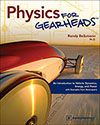|
Now Available! |
Physics for Gearheads
Price: $119.95
|

BestRide.com - June 10, 2015
BOOKS: "Physics for Gearheads" Answers All the Auto Physics Questions You Were Too Dumb To Ask
Randy Beikmann - holder of a Ph.D. in mechanical engineering from the University of Michigan - has come up with a way for all of us half-educated car people to understand what our cars are doing underneath us as we drive. Physics for Gearheads is a full-on textbook of answers to the questions we motorheads have every single day.
Motorcyclists - at least those who haven't ridden straight through a corner - have a seat of the pants understanding of physics. How you get through a corner is a sort of black magic of physics called countersteering. To understand how all this works, you turn to the subhead "Tire Force Generation in Motorcycles" in Biekmann's book Physics for Gearheads, and read the explanation of how it works:
"Instead of steering into a curve, you initially steer out of the curve, which leans you into it. Apparently, a lot of riders don't even realize this, because they drive by instinct. But tugging on the right handlebar banks you into a left turn, and vice versa. Good to know in a tight spot."
So there you have a very basic explanation of how countersteering works, which you can find in a lot of books on motorcycling basics. Where Beikmann's book shines, though, is in the deeper explanation:
"With a given load FLoad and a given camber angle Γ (spelled 'gamma' and pronounced GA-muh), the tire will produce a certain lateral force FLat. Without getting into the details, as the tire leans, its contact patch material becomes warped from a banana shape into a straight line, This distortion of the carcass results in the tire pushing sideways, producing a lateral force FLat, called 'camber thrust.'
"While camber thrust produces the majority of the cornering force in a motorcycle, the rider does use slip angle to adjust the exact cornering force needed at a certain lean angle. You might say that camber puts it in the ballpark, while lateral slip fine-tunes; but the rider is probably unaware of doing it."
If that all sounds wayyyy too complicated, there are ample charts, graphs and illustrations to make sense of it all.
Beikmann spent 30 years as an automotive engineer with General Motors. He's a technical specialist in noise and vibration at the Milford Proving Grounds, and he's published numerous papers on powertrain noise and vibration.
It's a substantial 593-page textbook, with 17 chapters, 6 appendices, an index, plus references and further reading, but it's not the kind of book you're going to sit down and read cover-to-cover. It's really designed to start answering specific questions you have about the physical forces working on our cars, trucks and motorcycles. The book provides straightforward answers written in plain English so you don't need a degree to understand what's going on.
The first chapter is what Beikmann calls a "warm-up lap," a very basic understanding of the physical properties that make a car work. From there, the balance of the chapters are broken into pairs:
- Kinematics, in Chapters 2 and 3
- Dynamics, in chapters 4 and 6
- Angular Dynamics, in chapters 8 and 9
- Dynamics in a Plane, in chapters 10 and 11
- Energy, in chapters 12 and 13
- Power, in chapters 14 and 15
- Statics and Quasi-Statics, in chapters 16 and 17
The missing chapters in that list are called "support chapters," used to describe things like forces, torque and vectors.
The beginning of each chapter has a list of terms describing physical quantities, their definitions, any special symbols you'll need to know, and units of measurement. The end of each chapter features a summary, pulling the new material together and providing perspective.
This could all be pretty dry stuff if Beikmann didn't write in such a friendly, helpful tone. It's a book that takes complex physical explanations and puts them in the real world, relating them to experiences we've all had behind the wheel, or under the hood.
If you've ever really wanted to understand how a car works, but, like me, you wasted your time in college getting a degree in English, this is the book for you. Lots of books exist about cars, and lots of books exist about physics, but none of them pull the two ideas together in a practical volume like this one. Think of this as "Physics for Dummies" for people who aren't dummies.

Review from and courtesy of BestRide.com - June 10, 2015
![[B] Bentley Publishers](http://assets1.bentleypublishers.com/images/bentley-logos/bp-banner-234x60-bookblue.jpg)
